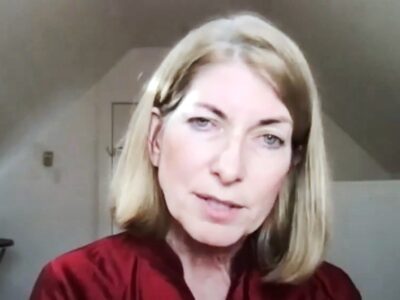On March 3, Community Solutions founder Rosanne Haggerty joined Santa Fe Mayor Alan Webber, and John Vu, Vice President of Strategy for Community Health at Kaiser Permanente, to discuss how cities and counties across the U.S. can be working differently to end homelessness at the All-Virtual Bloomberg CityLab 2021.
Moderated by CityLab reporter Kriston Capps, the discussion explored the key shifts communities can make to reduce and end homelessness in the face of the ongoing pandemic. Built for Zero communities like Santa Fe are leveraging federal stimulus dollars to create housing solutions for their most vulnerable neighbors.
Treating homelessness as an urgent public health crisis
Haggerty explained how Built for Zero’s methodology is inspired by public health and focused on driving down to zero homelessness at the population level.
“Built for Zero […] is very much about driving down to an end state, closely informed by public health thinking and practice.“ Haggerty said. “This is very much a model we see for the complexity of services and problems that surround homelessness.”

Many principles of the Built for Zero methodology are inspired by health care systems, underlining the urgency to end homelessness as a public health crisis.
Vu spoke of how the past year exposed how homelessness and COVID-19 are linked public health crises. Recognizing this connection between health care and homes, Kaiser Permanente became a partner of Community Solutions in 2019.
“In the public health crisis this year, we have seen how important data is and how to track this in contact tracing and all these issues of testing and who gets vaccinated. It is equally challenging and worse with populations experiencing homelessness. And the potential for outbreak in congregate settings just go up exponentially, as well as the challenges of social distancing ,when you’ve got beds that need to be put together or encampments,” Vu said.
“There is no silver lining to COVID, but one of the things that it has forced us to do is to look [homelessness] in the eye and recognize that the by-name list is what we really need.”
Mayor Alan webber of santa fe, nm
Santa Fe responds to the pandemic
Due to COVID-19, communities across the U.S. are standing at the edge of an unprecedented housing and homelessness crisis. Before joining Built for Zero, Santa Fe was focused on addressing homelessness, rather than ending it.
“People were doing the right work they felt good about, but they were not addressing the systemic problem in a way that applied resources most effectively,” Webber said. ”By joining Built for Zero, we could actually be prepared for when COVID hit. We had a mental model of all the resources in the community, and we also had people willing to step away from their business-as-usual good intentions and adopt new practices.”
In Santa Fe, the city recently leveraged federal funding to buy an extended stay hotel, which will provide more than 120 people with a safe place to live. This purchase of Santa Fe Suites, a joint venture involving Community Solutions and many local partners, will accelerate the city’s efforts to end homelessness.
“There is no silver lining to COVID, but one of the things that it has forced us to do is to look [homelessness] in the eye and recognize that the by-name list is what we really need,” Webber said.
Communities in Built for Zero know every person experiencing homelessness by name and need as a part of a real-time, by-name list, and building it is one of the first steps communities take to end homelessness.
“The by-name information means you have the capacity to mentor a dynamic problem with a dynamic system. We know what is going on in real time, who is coming into homelessness, who is returning from being assisted […] basically, it is a mindset shift for how you get your arms around a complex problem like a public health crisis,” Haggerty said.
The clear path forward
The Built for Zero model relies on establishing a community-wide commitment to ending homelessness and holding one another accountable to this goal. Communities have found that political will to end homelessness is one of the most important steps to reaching functional zero.
“It’s in everyone’s interest to grab this issue as the urgent public health and racial justice issue that it is. There’s not a quick fix, but there is a clear path.”
ROSANNE haggerty, president of community solutions
“We need mayors and county executives to use power of influence to get the right group of people to the table. We have every reason to expect homelessness to be solved, and the evidence is there even through COVID,” Haggerty said. “Three [communities] have ended chronic homelessness. Calling people to the table and saying ‘there is a better way’ is the place it starts.”
Mayor Webber explained the mindset shift that’s necessary for communities to test new ideas and make measurable progress towards driving down homelessness.
“There is a way of actually breaking out of old habits — even if they seem good and well-intentioned — breaking out of them if you are prepared, and you are able to use the money effectively […] It is a systems approach rather than a broken systems patch-it-together approach,” Webber said.
“It’s in everyone’s interest to grab this issue as the urgent public health and racial justice issue that it is. There’s not a quick fix, but there is a clear path,” Haggerty said.




